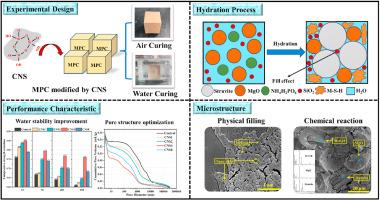胶体纳米二氧化硅改性磷酸镁水泥的水稳定性改善及其机理
IF 10.8
1区 工程技术
Q1 CONSTRUCTION & BUILDING TECHNOLOGY
引用次数: 0
摘要
本文系统研究了胶体纳米二氧化硅(CNS)在增强磷酸镁水泥(MPC)水稳定性方面的积极作用及其内在机理。实验结果表明,CNS 的成核效应加速了中间相变过程,并显著提高了 MPC 的早期晶石形成率。此外,从孔径分布来看,CNS 的加入导致了大孔向凝胶孔的转变。值得注意的是,CNS 的填充效应和新型水合产物的形成被认为是提高水稳定性和优化孔结构的关键因素。模拟实验进一步验证了氯化萘磺酸可直接与死灼氧化镁反应生成新型凝胶相--硅酸镁水合物(M-S-H),这证实了二氧化硅在 MPC 中可能发生水化反应。本文章由计算机程序翻译,如有差异,请以英文原文为准。


Water stability improvement and mechanism of magnesium phosphate cement modified by colloidal nano silica
Colloidal nano silica (CNS) demonstrated positive effects in enhancing the water stability of magnesium phosphate cement (MPC), and the underlying mechanism was investigated systematically in this paper. The experimental results showed that the nucleation effect of CNS accelerated the intermediate phase transition process and significantly enhanced the struvite early formation rate of MPC. Moreover, the addition of CNS led to a shift from macropore to gel pores observed from pore size distribution. Notably, the filling effect of CNS and the formation of novel hydration products were identified as critical factors in enhancing water stability and optimizing pore structure. Simulation experiments provided further validation that CNS could directly react with dead-burnt magnesium oxide to generate a novel gel phase-magnesium silicate hydrate (M-S-H) which confirmed a possible hydration reaction of silica in MPC.
求助全文
通过发布文献求助,成功后即可免费获取论文全文。
去求助
来源期刊

Cement & concrete composites
工程技术-材料科学:复合
CiteScore
18.70
自引率
11.40%
发文量
459
审稿时长
65 days
期刊介绍:
Cement & concrete composites focuses on advancements in cement-concrete composite technology and the production, use, and performance of cement-based construction materials. It covers a wide range of materials, including fiber-reinforced composites, polymer composites, ferrocement, and those incorporating special aggregates or waste materials. Major themes include microstructure, material properties, testing, durability, mechanics, modeling, design, fabrication, and practical applications. The journal welcomes papers on structural behavior, field studies, repair and maintenance, serviceability, and sustainability. It aims to enhance understanding, provide a platform for unconventional materials, promote low-cost energy-saving materials, and bridge the gap between materials science, engineering, and construction. Special issues on emerging topics are also published to encourage collaboration between materials scientists, engineers, designers, and fabricators.
 求助内容:
求助内容: 应助结果提醒方式:
应助结果提醒方式:


